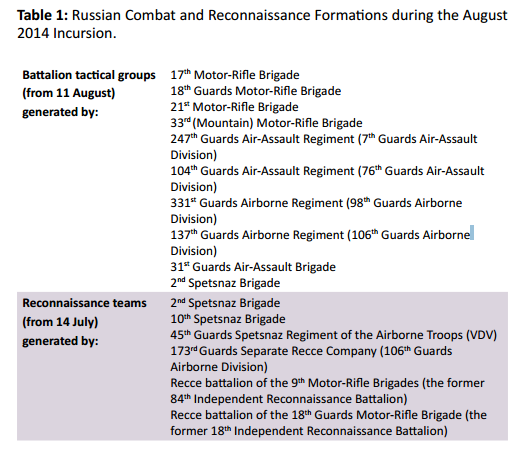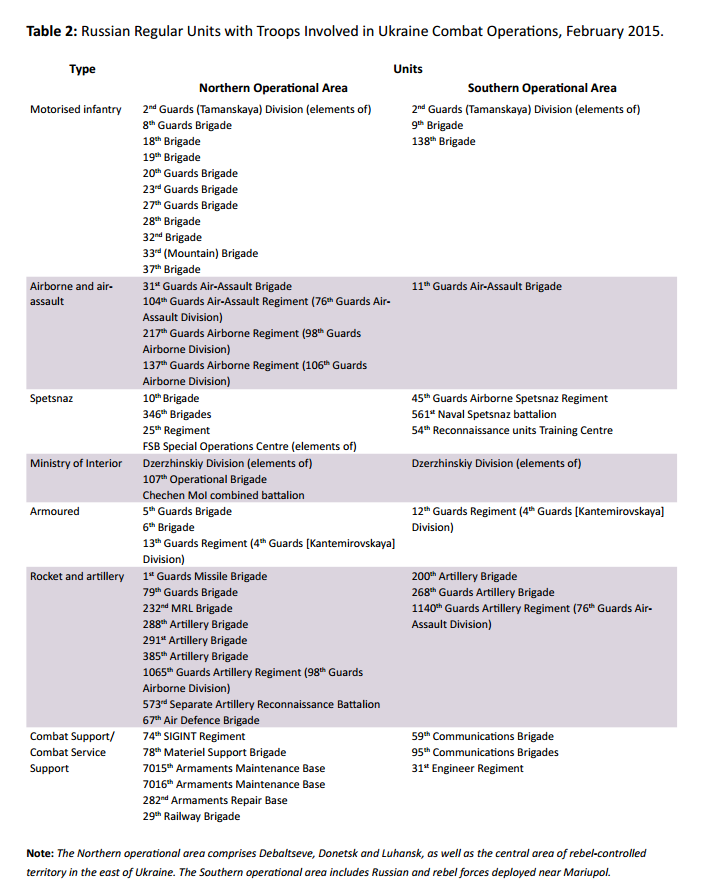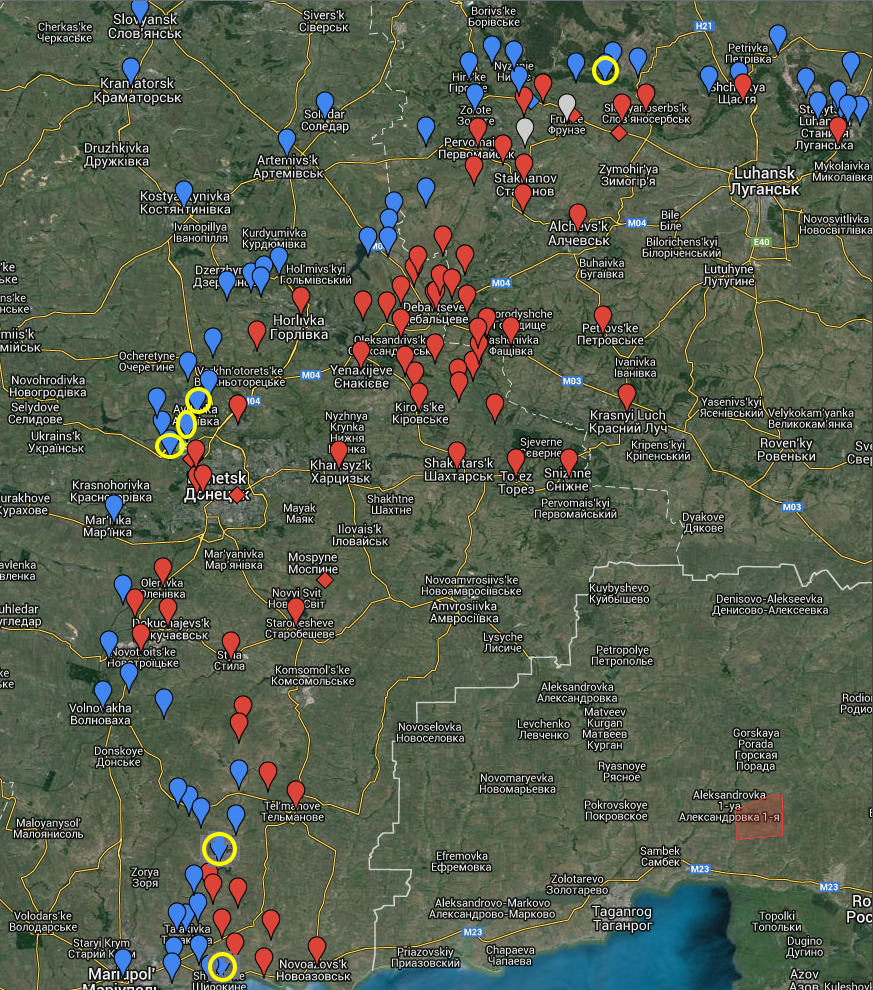Yesterday’s live coverage of the Ukraine conflict can be found here. An archive of our liveblogs can be found here. For an overview and analysis of this developing story see our latest podcast.
Please help The Interpreter to continue providing this valuable information service by making a donation towards our costs.
For links to individual updates click on the timestamps.
For the latest summary of evidence surrounding the shooting down of flight MH17 see our separate article: Evidence Review: Who Shot Down MH17?
There are reports that the Ukrainian-held village of Peski, just to the north-west of Donetsk, is under attack this afternoon.
Dialog.ua reported at 14:34 (12:34 GMT) that Yuriy Beryoza, commander of the Dnipro-1 battalion, had written on his Facebook page that Russian-backed forces were “incessantly” attacking Peski with small arms and, “periodically,” mortars.
Translation: #Peski fighting has gone on for several hours. They’re hitting with something heavy. Rockets, that shred apart in the air, are continuously flying in. In general, the ceasefire.
Translation: The terrorists are shelling Shirokino and Peski, there are fatalities.
— Pierre Vaux
Sweden’s Aftonbladet reports today that The Left Party (Vänsterpartiet), a Swedish socialist party born out of the Communist Party of Sweden with 21 seats in parliament, has provided a group in eastern Ukraine, linked to separatist militants, with 219,000 kronor ($25,407.64) in funding.
TheLocal.se, a site covering Swedish news in English, summarised the Aftonbladet report:
According to Sweden’s Aftonbladet newspaper, which broke the story on Wednesday, 219 000 kronor ($25,397) was moved from a bank account linked to the Left Party’s aid organisation VIF, to a private bank account in the name of an ex-girlfriend of Borotba’s leader, Victor Shapinov.
In an interview with the newspaper the woman said: “He told me to just take the money, because I have a foreign currency account at the bank”, adding that she “asked no questions” at the time about what it was for.
The paper speculates that the Left Party may have been tricked by Borotba into thinking the money was bound for humanitarian work in the region.
According to Aftonbladet, The Left Party ceased cooperation with Borotba in December last year.
Victor Shapinov, leader of Borotba (fight or struggle in Ukrainian), was named by Russia’s state-owned RIA Novosti news agency last year as “one of the organisers of the Kharkiv and Odessa AntiMaidan.”
In the RIA Novosti interview, Shapinov presented his role as one in a struggle against “Nazis” in the Maidan movement, claiming that members of his group had been beaten and arrested.
He also said that, “despite the strong statements of support from Novorossiya and the resistance to the junta, there is no help from Russian authorities and organisations.”
TheLocal notes that
Shapinov has previously worked as a political consultant for Vladimir Putin’s United Russia party. He moved to Ukraine in 2006 and founded the Borotba movement in May 2011. He was arrested in November 2014 in the former Soviet Republic of Moldova amid rumours he was trying to promote Russian separatism in the state and even overthrow the political regime there, although Moldovan authorities have never made public the reason he was held.
This would suggest the possibility that Shapinov is not a mere local activist, but a GRU agent, working to destabilise areas of Russian interest.
— Pierre Vaux
UPDATED: The United States has placed new sanctions on a Russian bank, 6 Russians, and 8 Russian-supported Ukrainian separatists today, just one day after accusing Moscow of deploying new troops and armor on the Ukrainian side of the border.
Reuters reports:
“If Russia continues to support destabilizing activity in Ukraine and violate the Minsk agreements and implementation plan, the already substantial costs it faces will continue to rise,” Adam Szubin, the Treasury Department’s acting undersecretary for terrorism and financial intelligence, said in a statement announcing the sanctions.
The entire list of those sanctioned can be found with our descriptions below and is printed on the Treasury’s website, here. There are some notable names. The Treasury Department’s bios of the sanctioned individuals can be found here, but we describe them below.:
– Sergei Abisov, the Minister of Internal Affairs for the Russian-appointed government in Crimea.
– Serhiy Arbuzov, Ukraine’s First Deputy Prime Minister under the Yanukovych government.
– Mykola Azarov, the former Prime Minister of Ukraine.
– Raisa Bogatyrova, the well-known former Ukrainian politician who has been wanted for embezzlement of state funds since she disappeared immediately following Yanukovych’s flight to Russia.
– Ekaterina Gubareva, the former “Minister of Foreign Affairs” for the self-proclaimed “Donetsk People’s Republic,” who now runs the charity that collects aid for “Novorossiya” fighters and is also the wife to Pavel Gubarev, the self-proclaimed “People’s Governor” of the DNR.
– Yuriy Ivakin, the so called “Minister of Internal Affairs” of the self-proclaimed “Lugansk People’s Republic.”
– Aleksandr Dugin, the Russian right-wing fascist leader and political thinker who may be well-known to many readers. Dugin is also the head of Eurasian Youth Union, the youth wing of the fascist and anti-Ukrainian Eurasian Party which has also been sanctioned today. The Treasury Department says “the Eurasian Youth Union has actively recruited individuals with military and combat experience to fight on behalf of the self-proclaimed DPR and has stated that it has a covert presence in Ukraine.”
– Pavel Kanishchev, who runs the Eurasian Youth Union’s federal network.
– Alexander Karaman, the Transdniestrian expatriate and pro-Russian rebel activist who moved to the Donbass to join this fight and who replaced Ekaterina Gubareva as the LNR’s “Minister of Foreign Affairs.”
– Oleksandr Khodakovskyy (Alexander Khodakovsky), the leader of the Russian-backed rebel group, the Vostok Battalion, featured often in The Interpreter’s reports on some of Ukraine’s heaviest fighting.
– Andrey Kovalenko, another leader of the Eurasian Youth Union.
– Oleg Kozyura, part of the Crimean occupation government, currently the Head of the Office of the Federal Migration Service in the City of Sevastopol .
– Roman Lyagin, the head of the Russian-backed separatists “election commission.”
– Serhil Zdriliuk, whom the Treasury Department says is a “senior ‘rebel commander’ [who] served as an aide to Igor Girkin (a.k.a Igor Strelkov), former “defense minister” of the self-proclaimed DPR. Zdriliuk and Girkin were involved in the takeover of Ukraine’s Crimea region that led to Russia’s illegal annexation of the region in March 2014.”
Beyond Dugin’s Eurasian Youth Union, the U.S. has also sanctioned the Russian National Commerce Bank (RNCB), which played a kjey role in assimilating many of Crimea’s banks after the peninsula as (illegally) annexed from Ukraine.
— James Miller
The United States is still reviewing whether or not it will send lethal aid to Ukraine. Defense One reports:
“We’re still working in the interagency group on reviewing a number of options including lethal defensive weapons, but I can’t give you a timetable on when we might have a decision on additional assistance,” Brian McKeon, the principal deputy under secretary of defense for policy, told members of the Senate Foreign Relations Committee in a Tuesday hearing.
The senators repeatedly grilled McKeon, Assistant Secretary of State for European and Eurasian Affairs Victoria Nuland and other officials on the delayed decision, but the witnesses gave no new information on the reasons for the delay or when a decision may be made.
We also know that the U.S.’s European allies, particularly Germany, talked the Obama administration out of sending lethal aid to Ukraine last month, as we reported yesterday:
However, U.S. Vice President Joe Biden has told Ukrainian President Petro Poroshenko that the U.S. will supply $75 million in new “non lethal” equipment. What’s on this list is important. AP reports:
Biden delivered the news in a call to Ukrainian President Petro Poroshenko (por-oh-SHEHN’-koh). The aid includes some small Raven drones systems, which can be launched by hand. The U.S. will also send 30 heavily armored Humvees and 200 other regular Humvees, as well as radios, counter-mortar radars and other equipment. All of the aid is nonlethal, and the drones are not armed.
This equipment is non-lethal because it contains no weapons. But Humvees can be equipped with weapons which Ukraine already has. (Ukraine has plenty of weapons in reserve, some of which, like the T-72 main battle tank, use Russian military parts so have not been deployed to the front. Some of those vehicles are likely outfitted with machine guns, for instance, which could be mounted on a Humvee). The drones and ground-scan radar are non-lethal in the sense that they are not weapons, but they are designed to help improve the accuracy and effectiveness of artillery and rockets. Radios may sound trivial, but our sources in various levels of the Ukrainian military and Ministry of Defense have frequently complained that Ukrainian communications equipment was all designed in Russia and thus their communications were easily monitored by the Russian military and Russian-supported forces.
However, many U.S. lawmakers are already angry that much of what the U.S. has promised to Ukraine has not yet reached the country. Foreign Policy reports:
“We have provided some significant defensive systems. We have not answered the entire shopping list,” Assistant Secretary of State Victoria Nuland told visibly frustrated senators at a hearing Tuesday morning. Brian McKeon, the principal deputy undersecretary of defense, said that some of the assistance, which includes radar systems and night-vision goggles, hasn’t been sent to Ukraine because of U.S. logistical or supply chain problems.
The admission infuriated some members of the panel, including its chairman, Sen. Bob Corker (R-Tenn.), who accused the Obama administration of playing “footsie with Russia.” Lawmakers asked specifically about an Associated Press report indicating that Obama told German Chancellor Angela Merkel in early February 2015 that he would not send weapons to Ukraine, echoing the European position. Since the meeting with Merkel, lawmakers from both sides of the aisle and officials from within Obama’s own administration have called on the president to answer Ukrainian President Petro Poroshenko’s request for guns and other weaponry.
Lawmakers were further incensed by the White House’s failure to meet a Feb. 15 deadline to report on the potential transfer of weapons to Kiev as required by the Ukraine Freedom Support Act, signed by Obama in December 2014. McKeon said there was no timetable for the report’s delivery.
— James Miller
Reuters reports that Jens Stoltenberg, the NATO Secretary General, has told journalists that Russia is continuing to send troops and military hardware into Ukraine.
Asked at a news conference about a U.S. diplomat’s remark that Russian tanks had crossed into Ukraine in recent days, he declined specific comment on that but said: “We … still see Russian presence and strong support for the separatists in eastern Ukraine. We see the delivery of equipment, forces, training. And so Russia is still in eastern Ukraine.
“Therefore we call on Russia to withdraw all its forces from eastern Ukraine and to respect the Minsk agreement.”
The Secretary General said that the current monitoring of the ceasefire was “by no means sufficient today,” as the OSCE was not being granted the necessary access and information.
Stoltenberg said he was concerned that weaponry which was not being monitored could be repositioned for future combat.
The US diplomat’s remark in question was a statement yesterday by Victoria Nuland, Assistant Scretary of State for European and Eurasian Affairs.
Nuland told a U.S. congressional hearing that Russian tanks and artillery had crossed into eastern Ukraine in recent days in breach of a ceasefire deal agreed in Minsk on Feb. 12.
This comes as Igor Sutyagin, a Russian military expert at the Royal United Services Institute in London, published a briefing paper on the deployment of Russian military forces in Ukraine.
Sutyagin has compiled information on specific military units deployed to Ukraine in three periods, the “reconnaissance teams” in earlier phase of the conflict, as separatist fighters fought for control of cities in the Donetsk region, the large-scale intervention by regular forces from August 11, and the current scale of force in February, 2015.


Sutyagin argues that the scale and type of units deployed indicates that Russia is actually struggling to sustain the operation in Ukraine, with eight out of ten field armies contributing troops to the main offensive last summer and autumn. Troops have been sent from as far east as Vladivostok and even the 201st base in Tajikstan. There has been, he claims, over-reliance on units from Siberia, far from the border, suggesting insufficient materiel and manpower in the western districts.
The moves to press conscript soldiers into contract service also reflects a lack of available manpower.
Sutyagin also details the continued deployment of troops after the ceasefire:
The Russian MoD kept sending reinforcements to the east of Ukraine even after the ceasefire was signed in Minsk on 13 February. Indeed, two days later detachments of the 2nd Guards were detected in combat near Mariupol, where they arrived as a fresh reserve to replace the 138th Motor-Rifle Brigade, which had suffered serious manpower losses over a three-week period.
Here Sutyagin makes an interesting point with regards to the deployment of Russian troops in small groups attached to other units, a policy which gave way, during the battle for Debaltsevo, to full-unit deployment:
At the same time, casualties have forced the Russian command, instead of using Battalion Tactical Groups originating from a single brigade or division, to establish ad hoc formations that combine detachments from different units into combined tactical groups. Those two facts combined prompted some observers to suggest there are no Russian regular units fighting as coherent formations in the combat zone – with only individual ‘volunteer’ servicemen fighting and the organised regular Russian military present in exclusively command roles and as specialist crews to operate the most sophisticated equipment. However, with a new round of fighting starting immediately after the ceasefire was signed, Russian units returned to prioritised forward locations, as the most capable strike force; rebel formations have in essence been used as cannon fodder. During the February fighting on the northern front, combined formations of Russian regulars have been detected on a number of occasions:
• On 1–2 February, a combined formation – consisting of the 8th Guards and 18th Guards Motor-Rifle brigades, 25th Spetsnaz Regiment, and elements of the 232nd MRL brigade – was involved in combat near Debaltseve
• At the same time, the 8th Guards Motor-Rifle Brigade deployed some of its personnel within a combined formation – of the 8th Guards Motor-Rifle Brigade and 5th Tank Brigade – to serve as infantry support to armoured forces near Gorlovka
• A combined formation of the 27th Guards Motor-Rifle Brigade and 217th Guards Airborne Regiment (98th Guards Airborne Division) moved to Logvinovo on 14 February when the combined formation of 136th Guards Motor-Rifle Brigade and 25th Spetsnaz Regiment fighting there to close the corridor to Debaltsevo had to be withdrawn after severe manpower losses. (The combined formation of the 27th Guards and 217th Guards Airborne was itself established around the core of the latter’s Battalion Tactical Group after it took heavy losses.)
• The 20th Guards Motor-Rifle Brigade’s tactical group had to be reformed into a combined formation with 18th Guards Motor-Rifle Brigade elements after 13 February; the 20th Guards elements were a substitute for the elements of the 8th Guards Motor-Rifle Brigade due to the latter’s substantial losses
• Other combined formations – of 19th Motor-Rifle Brigade with 10th Spetsnaz Brigade; of the 13th Guards Tank Regiment (4th Guards [Kantemirovskaya] Tank Division) with the 32nd Motor-Rifle brigade; and of the 104th Guards Air-Assault Regiment (76th Guards Air-Assault Division) with the ‘Kalmius’ rebel formation – were also detected in combat in the Northern Operational Area in February
• The 9th Motor-Rifle Brigade operated in a combined formation with elements of an unidentified unit in the Southern Operational Area.
Read the full report here.
— Pierre Vaux
Novosti Donbassa reports on ATO spokesman Anatoly Stelmakh’s press briefing on last night’s attacks by Russian-backed fighters. Notably, Stelmakh claimed that Peski, north-west of Donetsk, had been shelled with a 120 mm mortar, a weapon which should have been withdrawn under the terms of the Minsk agreement.
The Interpreter translates:
“Peski, Opytnoye and Avdeyevka were shelled over the night with mortars and automatic grenade launchers. At 21:00 [19:00 GMT] and 23:00 [21:00 GMT], the terrorists fired on the village of Peski with a 120 mm mortar.
The enemy used small arms twice in the Mariupol area, near the villages of Chermalyk and Shirokino, and one time – not far from the settlement of Sokolniki, in the Lugansk region.”
Mariupol news site 0629.com.ua reported that Oleg Sushinsky, press officer for the city’s military headquarters, had told them that the attack on Ukrainian troops outside Chermalyk, to the north-east, had come at 23:46 (21:46 GMT).
Sushinsky said there were no reports of casualties and that the rest of the night had passed quietly. He also reported that 12 drone flights had been recorded over the area yesterday and last night.
Novosti Donbassa reported that the press office of the Azov regiment had reported that attacks on Ukrainian positions in Shirokino had continued throughout the whole day yesterday.
Shelling reportedly began at 7:15 (5:15 GMT) and continued until dark fell.
Azov claimed that Russian-backed fighters did not engage directly as they had on Monday, but fired on Ukrainian positions with 120 mm mortars, rocket-propelled grenades and small arms.

— Pierre Vaux
Ukrainska Pravda reports that Vladislav Seleznyov, press secretary for the General Staff, has announced that one Ukrainian soldier has been killed and four wounded over the last 24 hours.
Speaking at a briefing at 9:00 (7:00 GMT), Seleznyov said (translated by The Interpreter):
“As a result of militant attacks on ATO forces, Ukraine has lost one serviceman, another four received injuries of varying severity.”
Seleznyov added that, as of March 11, 408 Ukrainian soldiers are in hospital.
— Pierre Vaux